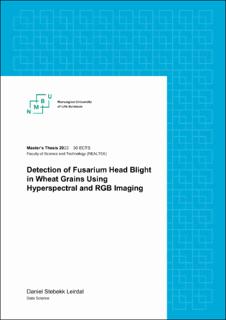| dc.description.abstract | In modern agriculture, it is imperative to ensure that crops are healthy and safe for consumption. Fusarium Head Blight (FHB) can cause significant damage to wheat grains by reducing essential components such as moisture, protein, and starch, while also introducing dangerous toxins. Therefore, accurately distinguishing between healthy and FHB-infected wheat grains is essential to guarantee stable and reliable wheat production while limiting financial losses and ensuring food safety. This thesis proposes effective methods to classify healthy and FHB infected wheat grains using Hyperspectral Imaging (HSI) and Red Green Blue (RGB) images. The approach includes a combination of Principal Component Analysis (PCA) with morphology, in addition to dark and white reference correction, to create masks for grains in each image. The classification for the hyperspectral images was achieved using a Partial Least Squares Discriminant Analysis (PLS-DA) model for hyperspectral images and a Convolutional Neural Network (CNN) model for RGB images. Both object-based and pixel-based approaches were compared for the PLS-DA model. The results indicated that the object-based approach outperformed the pixel-based approach and other well-known machine learning algorithms, including Random Forest (RF), linear Support Vector Machine (SVM), Stochastic Gradient Descent (SGD) calibrated one-vs-all and DecisionTree. The PLS-DA model using the object-based method yielded better results when tested on all wheat varieties, achieving an F1-score of 99.4%. Specific wavelengths were investigated based on a loading plot, and four effective wavelengths were identified, 953 nm, 1373 nm, 1923 nm and 2493 nm, with classification accuracy found to be similar to the full spectral range. Moreover, the moisture and water content in the grains were analyzed using hyperspectral images through an aquagram, which demonstrated that healthy grains exhibited higher absorbance values than infected grains for all Water Matrix Coordinates (WAMACS). Furthermore, the CNN model was trained on cropped individual grains, and the classification accuracy was similar to the PLS-DA model, with an F1- score of 98.1%. These findings suggest that HSI is suitable for identifying FHB-infected wheat grains, while RGB images may provide a cost-effective alternative to hyperspectral images for this specific classification task. Further research should consider to explore the potential benefits of HSI for deeper investigations into how water absorption affects spectral measurements and moisture content in grains, in addition to user-friendly interfaces for deep learning based image classification. | |
